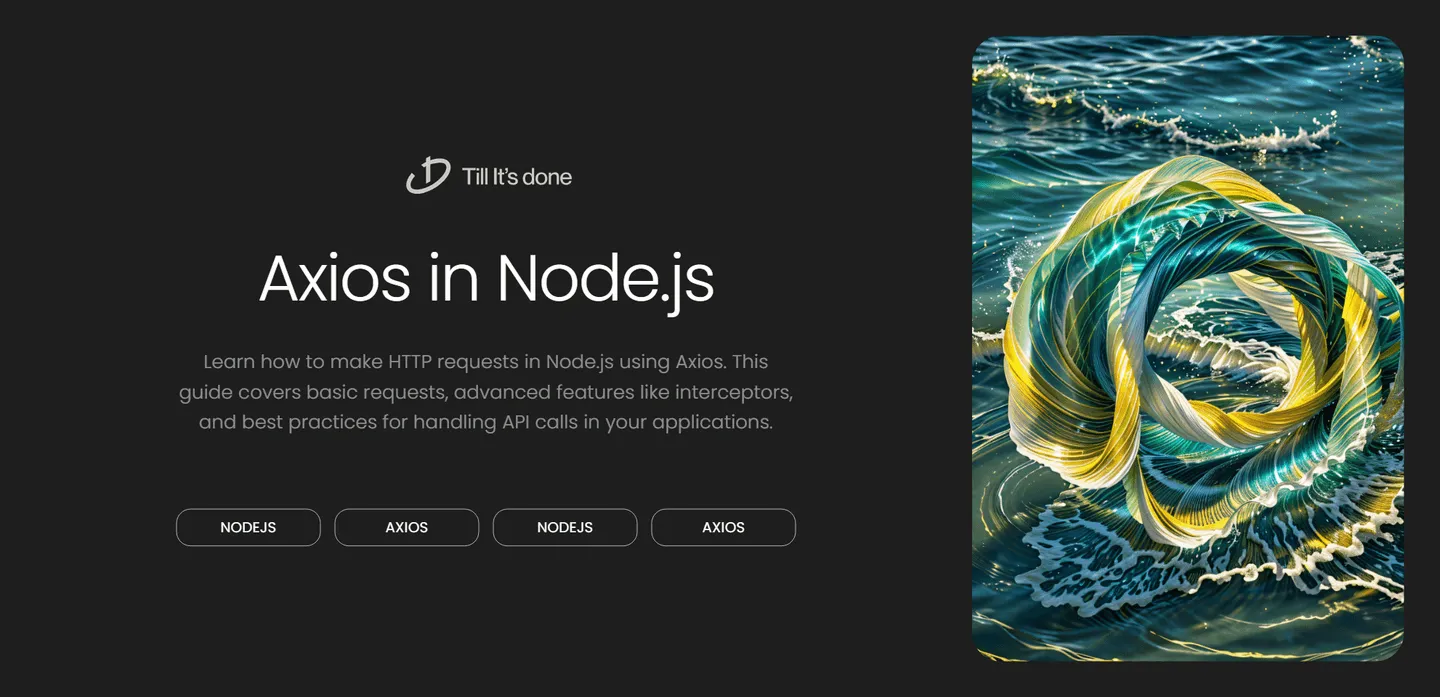- Services
- Case Studies
- Technologies
- NextJs development
- Flutter development
- NodeJs development
- ReactJs development
- About
- Contact
- Tools
- Blogs
- FAQ
Making API Requests with Axios in Node.js
This guide covers basic requests, advanced features like interceptors, and best practices for handling API calls in your applications.

Making API Requests with Axios in Node.js: A Comprehensive Guide

In today’s interconnected world, making HTTP requests is a fundamental part of web development. While Node.js provides built-in modules for handling HTTP requests, Axios has emerged as a powerful and elegant solution that simplifies the process. Let’s dive into how you can leverage Axios in your Node.js applications to make API requests like a pro.
Getting Started
First things first, you’ll need to set up your project and install Axios. Open your terminal and run:
npm install axiosAfter installation, you can import Axios into your project:
const axios = require('axios');
Making Your First Request
Axios makes HTTP requests incredibly straightforward. Here’s how you can make basic GET and POST requests:
// Making a GET requestasync function fetchData() { try { const response = await axios.get('https://api.example.com/data'); console.log(response.data); } catch (error) { console.error('Error:', error.message); }}
// Making a POST requestasync function createResource() { try { const data = { name: 'John Doe', email: 'john@example.com' }; const response = await axios.post('https://api.example.com/users', data); console.log('Created:', response.data); } catch (error) { console.error('Error:', error.message); }}Advanced Features
Axios isn’t just about basic requests - it comes packed with powerful features that make API interactions more robust and flexible.
Configuration and Defaults
You can create custom instances with specific configurations:
const api = axios.create({ baseURL: 'https://api.example.com', timeout: 5000, headers: {'X-Custom-Header': 'foobar'}});
Interceptors
Interceptors are one of Axios’s most powerful features, allowing you to transform requests and responses:
// Request interceptoraxios.interceptors.request.use(config => { // Add authorization header config.headers.Authorization = `Bearer ${getToken()}`; return config;});
// Response interceptoraxios.interceptors.response.use( response => response, error => { if (error.response.status === 401) { // Handle unauthorized access refreshToken(); } return Promise.reject(error); });Best Practices and Error Handling
When working with Axios, implementing proper error handling and following best practices is crucial:
async function robustApiCall() { try { const response = await axios.get('/api/data', { timeout: 5000, validateStatus: status => status < 500 }); return response.data; } catch (error) { if (error.response) { // Server responded with error status console.error('Server Error:', error.response.status); } else if (error.request) { // Request made but no response console.error('Network Error'); } else { // Error in request configuration console.error('Request Error:', error.message); } throw error; }}Remember to handle responses appropriately and implement retry mechanisms for failed requests when necessary. Axios makes this easier with its comprehensive error handling capabilities.

Conclusion
Axios has revolutionized how we handle API requests in Node.js applications. Its promise-based structure, rich feature set, and elegant syntax make it an invaluable tool for modern web development. Whether you’re building a small application or a large-scale system, Axios provides the flexibility and reliability you need for handling HTTP requests effectively.
Remember to keep your code clean, implement proper error handling, and leverage Axios’s advanced features when needed. Happy coding!
 สร้างเว็บไซต์ 1 เว็บ ต้องใช้งบเท่าไหร่? เจาะลึกทุกองค์ประกอบ website development cost อยากสร้างเว็บไซต์แต่ไม่มั่นใจในเรื่องของงบประมาณ อ่านสรุปเจาะลึกตั้งแต่ดีไซน์, ฟังก์ชัน และการดูแล พร้อมตัวอย่างงบจริงจาก Till it’s done ที่แผนชัด งบไม่บานปลายแน่นอน
สร้างเว็บไซต์ 1 เว็บ ต้องใช้งบเท่าไหร่? เจาะลึกทุกองค์ประกอบ website development cost อยากสร้างเว็บไซต์แต่ไม่มั่นใจในเรื่องของงบประมาณ อ่านสรุปเจาะลึกตั้งแต่ดีไซน์, ฟังก์ชัน และการดูแล พร้อมตัวอย่างงบจริงจาก Till it’s done ที่แผนชัด งบไม่บานปลายแน่นอน  Next.js สอน 14 ขั้นตอนเบื้องต้น: สร้างโปรเจกต์แรกใน 30 นาที เริ่มต้นกับ Next.js ใน 14 ขั้นตอนเพียงแค่ 30 นาที พร้อม SSR/SSG และ API Routes ด้วยตัวอย่างโค้ดง่าย ๆ อ่านต่อเพื่อสร้างโปรเจ็กต์แรกได้ทันทีที่นี่
Next.js สอน 14 ขั้นตอนเบื้องต้น: สร้างโปรเจกต์แรกใน 30 นาที เริ่มต้นกับ Next.js ใน 14 ขั้นตอนเพียงแค่ 30 นาที พร้อม SSR/SSG และ API Routes ด้วยตัวอย่างโค้ดง่าย ๆ อ่านต่อเพื่อสร้างโปรเจ็กต์แรกได้ทันทีที่นี่  วิธีสมัคร Apple Developer Account เพื่อนำแอปขึ้น App Store ทีละขั้นตอน อยากปล่อยแอปบน App Store ระดับโลก มาอ่านคู่มือสมัคร Apple Developer Account พร้อมเคล็ดลับ TestFlight และวิธีอัปโหลดที่ง่ายในบทความเดียวนี้ได้เลย
วิธีสมัคร Apple Developer Account เพื่อนำแอปขึ้น App Store ทีละขั้นตอน อยากปล่อยแอปบน App Store ระดับโลก มาอ่านคู่มือสมัคร Apple Developer Account พร้อมเคล็ดลับ TestFlight และวิธีอัปโหลดที่ง่ายในบทความเดียวนี้ได้เลย  TypeScript Interface คืออะไร? อธิบายพร้อมวิธีใช้และข้อแตกต่างจาก Type เรียนรู้วิธีใช้ TypeScript Interface เพื่อสร้างโครงสร้างข้อมูลที่ปลอดภัยและเข้าใจง่าย พร้อมเปรียบเทียบข้อดีข้อแตกต่างกับ Type ที่คุณต้องรู้ ถูกรวมเอาไว้ในบทความนี้แล้ว
TypeScript Interface คืออะไร? อธิบายพร้อมวิธีใช้และข้อแตกต่างจาก Type เรียนรู้วิธีใช้ TypeScript Interface เพื่อสร้างโครงสร้างข้อมูลที่ปลอดภัยและเข้าใจง่าย พร้อมเปรียบเทียบข้อดีข้อแตกต่างกับ Type ที่คุณต้องรู้ ถูกรวมเอาไว้ในบทความนี้แล้ว  Material-UI (MUI) คืออะไร อยากสร้าง UI สวยงามและเป็นมืออาชีพในเวลาอันรวดเร็วใช่ไหม มาทำความรู้จักกับ Material-UI (MUI) ที่ช่วยให้คุณพัฒนาแอปพลิเคชันบน React ได้ง่ายและดูดีในทุกอุปกรณ์
Material-UI (MUI) คืออะไร อยากสร้าง UI สวยงามและเป็นมืออาชีพในเวลาอันรวดเร็วใช่ไหม มาทำความรู้จักกับ Material-UI (MUI) ที่ช่วยให้คุณพัฒนาแอปพลิเคชันบน React ได้ง่ายและดูดีในทุกอุปกรณ์  เปรียบเทียบ 3 วิธีติดตั้ง install node js บน Ubuntu: NVM vs NodeSource vs Official Repo แบบไหนดีที่สุด? เรียนรู้วิธีติดตั้ง Node.js บน Ubuntu ด้วย NVM, NodeSource หรือ Official Repo เลือกวิธีที่เหมาะกับความต้องการของคุณ พร้อมเปรียบเทียบ เพื่อการพัฒนาที่มีประสิทธิภาพ!
เปรียบเทียบ 3 วิธีติดตั้ง install node js บน Ubuntu: NVM vs NodeSource vs Official Repo แบบไหนดีที่สุด? เรียนรู้วิธีติดตั้ง Node.js บน Ubuntu ด้วย NVM, NodeSource หรือ Official Repo เลือกวิธีที่เหมาะกับความต้องการของคุณ พร้อมเปรียบเทียบ เพื่อการพัฒนาที่มีประสิทธิภาพ! Talk with CEO
We'll be right here with you every step of the way.
We'll be here, prepared to commence this promising collaboration.
Whether you're curious about features, warranties, or shopping policies, we provide comprehensive answers to assist you.


